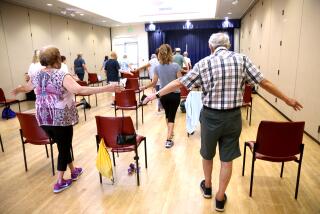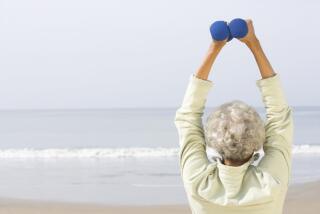Empowerment for Your 10 Lower Digits
- Share via
A friend recently confided that she was once voted “ugliest feet in my entire college.” Her feet, she says, have everything. Warts. Calluses. Bunions. Corns.
But no matter where she’s starting from, and no matter how she’s abused her feet in the past, my friend is now on the straight and narrow. In the company of two nurturing, supportive friends, she performed her first-ever foot self-exam.
What, you’ve never heard of a foot self-exam? If the American Orthopaedic Foot and Ankle Society has its way, that will change. Millions of Americans will soon be sliding their hands inside their shoes, struggling to pick up marbles with their toes and wetting their feet, then stomping on bits of brown paper to check for flat-footedness or high arches. Do it in the privacy of your home, or together with a gaggle of friends. It’s way more fun than an “adult toys” party. (Well, it’s fun, anyway.)
To learn more about the “Foot Fitness for Life” campaign--which kicked off last week--we visited the society’s Web site (https://www.aofas.org) and chatted with Dr. Carol Frey of UCLA’s Orthopedic Hospital. She had much sage advice. After reminding us of that advice our mothers used to give about the importance of buying good shoes (for more on this, see Karen Voight’s column this week) Frey noted that “toes are very important for balance--they act like little tripods.” She then directed us to a host of toe-strengthening exercises at the Web site, with pictures of toes pulling and pushing rubber bands and squeezing tight against small corks wedged between each of them.
We didn’t get that far, but we did, as instructed, take off our shoes and stand next to them to see if the shape of our shoes matched the actual shape of our feet. (My feet instantly splayed out way wider than the elegant suede ankle boots I was wearing.) We reached inside our warm, slightly moist shoes to check for pain- and pressure-causing ridges and seams, then squeezed our toenails till they were white to make sure that the blood flowed back quickly upon release. We rubbed pencil erasers over the top, sides and bottom of our feet to make sure all four “quadrants” were equally sensitive.
We didn’t, as instructed, try picking up marbles with our toes, a sign, says Frey, of “excellent” toe strength (we couldn’t find any in the house), nor did we try picking up a towel (which would merely have been “very good.”) But we all managed to manipulate a catnip mouse. And my “ugly-footed” friend should be proud of the fact that she could balance longer on one foot with her eyes shut than either of her friends.
Senior Citizens: Shattering the Myths
We also received results of a survey about senior citizens conducted by SCAN Health Plan, a Long Beach-based HMO “for seniors age 65 to 106.” (They dump ‘em at 106? No, no, a SCAN spokesman assured us: That just happens to be the age of the plan’s oldest member.) The survey, which polled about 100 social workers who coordinate care for members of the plan, asked them to list the top 10 myths younger people harbor about seniors.
* Top myth: Seniors are not interested in sex. In fact, the plan points out, the American Assn. of Retired Persons has reported that over half of men and a quarter of women age 60 to 74 feel that sex is important to the quality of their lives. About 31% of men and 24% of women said they had sexual intercourse at least once a week.
* Two other myths: Seniors don’t like change and are afraid of technology. But in a SCAN survey, 86% said they were open to change and new ideas--and 35% reported having a personal computer in their home. (The number is similar in the 64-74 and the 75-89 age brackets.)
* Another myth: Seniors are not interested in current events. SCAN has found that seniors are actually deeply interested in following the news, frequently watching news shows on TV and regularly reading newspapers and magazines.


